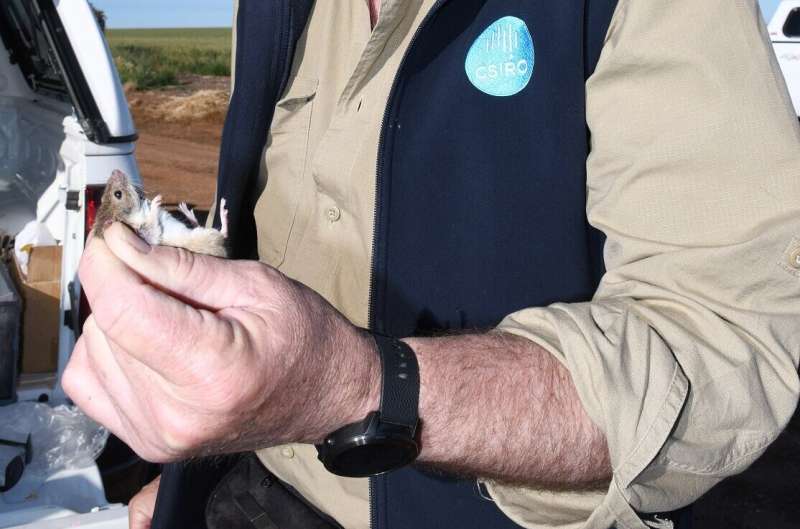Research confirms new baiting regime is effective for mouse management in agriculture

New research led by Australia's national science agency, CSIRO, has found that mouse populations can be reduced significantly by doubling the amount of zinc phosphide (ZnP) in grain baits used for broadscale agriculture.
The results of an in-field study, published in Wildlife Research, confirm those of earlier laboratory studies that demonstrated a lower sensitivity of mice to ZnP than previously reported.
The studies were undertaken in response to concerns from farmers, who suspected mouse baits were not as effective as they needed to be to control mice in broadscale agriculture, particularly when mouse numbers were high.
With investment from the Grains Research and Development Corporation (GRDC), CSIRO researchers embarked on a series of studies to reassess the sensitivity of mice to ZnP in the laboratory and the effectiveness of a new bait formulation in the field.

The Wildlife Research paper is the third in a series investigating the responses of mice to ZnP baits. The initial two publications are the first efficacy studies done in Australia since ZnP was registered for agricultural use.
CSIRO researcher Mr. Steve Henry said the first study published in Pest Management Science found that bait consisting of grains coated with 25 g ZnP/kg grain did not always provide a lethal dose to mice, and mice that didn't die from an initial feed of this bait became bait averse.
"We followed up with a second study, now published in Integrative Zoology, that reassessed the sensitivity of mice to ZnP. The results showed that mice were significantly less sensitive to ZnP than previously reported," Mr Henry said.
"These results highlighted the importance of every bait grain needing to be a lethal dose as there is no guarantee that mice will find and consume more than one baited grain, and consumption of a sub-lethal dose leads to aversion.
"The final study conducted near Parkes, NSW, took the findings of our laboratory tests into the field and confirmed that 50 g ZnP/kg grain bait is required to consistently reduce mouse populations.
"The findings confirmed that the 50 g ZnP/kg grain bait was able to achieve more than an 80 percent reduction in mouse populations more than 90 percent of the time," he said.
GRDC Pests Manager Dr. Leigh Nelson said the three studies provide a solid body of evidence for the superior efficacy of the 50 g ZnP/kg grain bait, which will give growers a more effective tool to manage mice and protect their crops.
"The use of 50g ZnP/kg grain baits should reduce the need for repeat baiting which is costly. Any savings on the bottom line from mouse damage would be welcomed by farmers," Dr. Nelson said.
"I would still encourage farmers to implement a suite of best practice management tactics to protect crops from mice," she said.
During the height of the 2021 mouse plague, the Australian Pesticides and Veterinary Medicines Authority granted an emergency use permit to increase the concentration of ZnP from 25g ZnP/kg to 50g ZnP/kg grain bait products based on CSIRO's laboratory research.
The efficacy research produced consistent, scientifically rigorous results and followed the principles defined by the Organisation for Economic Co-operation and Development (OECD) guidelines and was approved by CSIRO's Wildlife, Livestock and Laboratory Animal Ethics Committee.
More information: Wendy A. Ruscoe et al, Improved house mouse control in the field with a higher dose zinc phosphide bait, Wildlife Research (2022). DOI: 10.1071/WR22009
Steve Henry et al, Effects of background food on alternative grain uptake and zinc phosphide efficacy in wild house mice, Pest Management Science (2021). DOI: 10.1002/ps.6720
Lyn A. HINDS et al, Acute oral toxicity of zinc phosphide: an assessment for wild house mice ( Mus musculus ), Integrative Zoology (2022). DOI: 10.1111/1749-4877.12666
Journal information: Pest Management Science
Provided by CSIRO





















